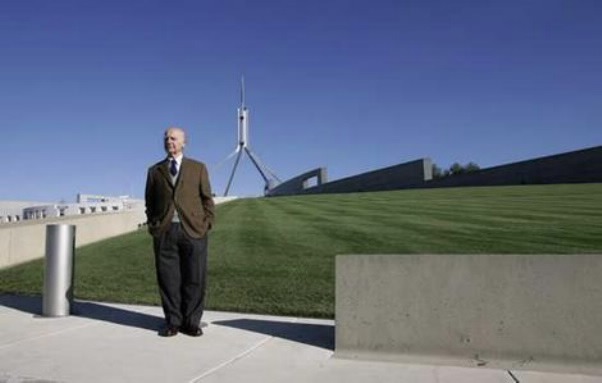 Since Gulf and Asian landscape architecture are improving, it may be a good time to dwell on past mistakes. The above photo is of the east corniche in Abu Dhabi. It was designed in conjunction with major traffic routes and exemplifies what goes wrong when landscape architecture work is supervised by firms of engineering consultants. The east corniche ‘park’ lies beside a 12 lane carriageway and flyover. It is a horrible place to be, especially during the rushhour. Pedestrian access just about impossible. Abu Dhabi is not short of money but this is a terrible way to waste water, space and resources. The ‘park’, better described as a ‘GARK‘, is ‘decorated’ with petunias, lawns and a fountain. Abu Dhabi is developing a grey water mains water supply but many lawns of this type are watered with drinking water. Grassland irrigation is calculated at 12 litres per square meter per day, which is 4,380 litres of water per square metre per year. Since there are about 58,000 sq m of grass, it must require about 250 million litres of water per year. In desert conditions, petunias probably require more water. Desalination plants dump their excess salt back into the Gulf. This will turn the mangroves yellow in perhaps 50 years. Beyond the gark, to the right, you can see the tops of the mangrove swamps which border the Abu Dhabi Gulf coast. The mangroves grow practically without maintenance in seawater. They are an ecological treasure chest and very beautiful. One wonders if the ‘designer’ of the Corniche east park ever woke up and felt really stupid about what he or she had done. It is not too late to commission a landscape architecture firm to claim the gark for the mangroves.
Since Gulf and Asian landscape architecture are improving, it may be a good time to dwell on past mistakes. The above photo is of the east corniche in Abu Dhabi. It was designed in conjunction with major traffic routes and exemplifies what goes wrong when landscape architecture work is supervised by firms of engineering consultants. The east corniche ‘park’ lies beside a 12 lane carriageway and flyover. It is a horrible place to be, especially during the rushhour. Pedestrian access just about impossible. Abu Dhabi is not short of money but this is a terrible way to waste water, space and resources. The ‘park’, better described as a ‘GARK‘, is ‘decorated’ with petunias, lawns and a fountain. Abu Dhabi is developing a grey water mains water supply but many lawns of this type are watered with drinking water. Grassland irrigation is calculated at 12 litres per square meter per day, which is 4,380 litres of water per square metre per year. Since there are about 58,000 sq m of grass, it must require about 250 million litres of water per year. In desert conditions, petunias probably require more water. Desalination plants dump their excess salt back into the Gulf. This will turn the mangroves yellow in perhaps 50 years. Beyond the gark, to the right, you can see the tops of the mangrove swamps which border the Abu Dhabi Gulf coast. The mangroves grow practically without maintenance in seawater. They are an ecological treasure chest and very beautiful. One wonders if the ‘designer’ of the Corniche east park ever woke up and felt really stupid about what he or she had done. It is not too late to commission a landscape architecture firm to claim the gark for the mangroves.
Category Archives: Landscape Architecture
Landscape and garden interpretation
Is this how we understand landscapes and gardens, natural and designed: through a friend’s camera reflected in our own glasses?
Image courtesy Mark Hodges.
Parliament House Canberra green roof
 Seeing Green over new ground cover proposal for Parliament House
Seeing Green over new ground cover proposal for Parliament House
One way of promoting green roofs and investigating the question of their accessibility is to look at some of the excellent examples which now exist.
Parliament House, Canberra is probably one of the world’s earliest and most successful green roofs. The Parliament House building was constructed in 1988 for $1.1 billion. The reason for the design of the green roof at the time was not due to sustainability as an imperative, rather it was conceived of “in order to preserve the shape of the hill on which it was built.” The Parliament building was constructed into the top of the hill and the roof was grassed over.
The issue of the grassed roof’s sustainability has been raised by the prolonged drought conditions of recent years. The architect of the original building, Romaldo Giurgola, is against all proposals to replant the roof with more sustainable hardy, native or drought tolerant plants. He believes that grass turf is an intimate part of the conception of the building and that any change “would completely destroy the form of the building.” http://greenroofs.wordpress.com/category/politics/
I suggest an online design competition to produce and debate alternative forms of cover which would satisfy the perceived need for a more sustainable ground cover and satisfy the demanding eye of the architect who rightly has regard to the heritage value of his work and to its design integrity.
Landscape Institute organization
The UK Landscape Institute should consider itself in the position of Robert the Bruce in a cave on Rathlin Island in the winter of 1305 watching a spider trying to make connections from one area of the cave’s roof to another. The LI has achieved good things but has suffered defeats. It should seize the breathing space offered by the recession to think again and plan for the future. ‘If at first you don’t succeed, try try again.’ Are the problems interconnected? Does the Constitution need to be revised?
The LI has lost too much money. It is out of touch with its membership. Its public profile is too low. Its recruitment is far too low. Major opportunities in garden design and landscape planning have been missed. It has too little influence on government policy. There is no PPG Note on landscape matters. UK landscape architects have not achieved the international renown enjoyed by other categories of British designer (eg architects). The LI Journal is a monthly disappointment. The organization is timid and tepid: not hot and yet uncool.
A symptom of the malaise is the complete redesign of the logo, journal and website every few years. Landscape design should be a classic brand – with new leadership and more responsive organization. The forthcoming Council elections are a time for change.
Sustainable urban design and landscape architecture – definitions
The Bruntland Commission may have set back sustainable urban design by half a century with an idiotic definition: “Sustainable development is development that meets the needs of the present without compromising the ability of future generations to meet their own needs” It gives anyone who wants it an excuse for doing nothing and claiming they are acting sustainability. What are my ‘needs’: one bicycle or two cars? And what are ‘needs’ of future generations: no bicycles and three cars?
The reason for Bruntland’s blunder is that sustainability is a relative concept, like ‘near’ and ‘far’, incapable of absolute definition. Is the moon near or far from the earth? It is very near for space travelers but very far for cyclists. We should boast an inability to design ‘sustainable cities’ but assert a competence in making cities ‘more sustainable’. As urban designers and landscape architects we do this by planning for fewer inputs and fewer outputs than the International Modern Cities which too many architects and engineers have designed, are designing and will design. Here are some examples:
1. Cities will require less input of water because we are expert in sustainable urban drainage systems – and they will have less output of waste water because we know how to detain and infiltrate water within urban areas.
2. Cities will require less import of construction materials from distant lands because we believe in respecting the Genius Loci and using the local materials which he provides for our use.
3. City building will involve less transport of excavated subsoil to dumps because we will use it design new landforms.
4. Less energy will be required for heating and cooling because we will orientate buildings correctly and design with microclimate.
5. Planting schemes will require less irrigation, less maintenance and less input of chemicals because we will make more use of native plant materials and will make lawns only when they have a social use.
6. People will walk more and cycle more because we will design beautiful and convenient paths – and we will do this before any roads or buildings are planned.
7. When people get more exercise they will have better health, so that the resource inputs for healthcare will also be reduced and we will have less medical waste to dispose of.
8. Buildings will be better insulated, because almost all of them will have vegetated roofs, and will therefore require less heating in winter and less cooling in summer.
9. Cities will be more compact because there will be less roadscape, fewer parking lots and less need for greenspace at street level – because we are going to make such wonderful skyparks and skygardens.
The inputs and outputs exemplified above are all measureable, just as the distance from the earth to the moon is measurable.
See also: Eco-city plans and sustainable design
Landscape architecture as stewardship of the land
The American Society of Landscape Architects (ASLA) states that “Landscape architecture encompasses the analysis, planning, design, management, and stewardship of the natural and built environments.” For me, there are two problems with this as a definition of landscape architecture: (1) ‘encompasses’ is a weak term – I would prefer a definition of landscape architecture (2) I feel uneasy with the term ‘stewardship’, possibly because my peasant ancestors suffered at the hands of harsh stewards employed by bullying barons.
In an interesting article on Steward Leadership in the Public Sector, Marilyn J. Smith writes that “The Merriam-Webster Dictionary defines stewardship as, “the conducting, supervising, or managing of something: Especially the careful and responsible management of something entrusted to one’s care” (Merriam-Webster, Inc. 1999). For Christians, stewardship began when God gave Adam dominion over the Garden of Eden. Even prior to the Bible, the ancient Greeks, Buddha, and Lao Tqu articulated the same concept (Spears, 1998: pp. 162-3).” Her comment is well-intentioned but deepens my uneasiness (1) I do not see landscape architecture as an essentially public sector activity (2) I can’t help remembering Ian McHarg’s comment on the Book of Genesis that ‘If you want to find one text which if believed and employed literally, or simply accepted implicitly, without the theological origins being known, will explain all of the destruction and all of the despoliation accomplished by Western man for at least these 2,000 years, then you do not have to look any further than this ghastly, calamitous text.’
See also: definitions of landscape architecture

